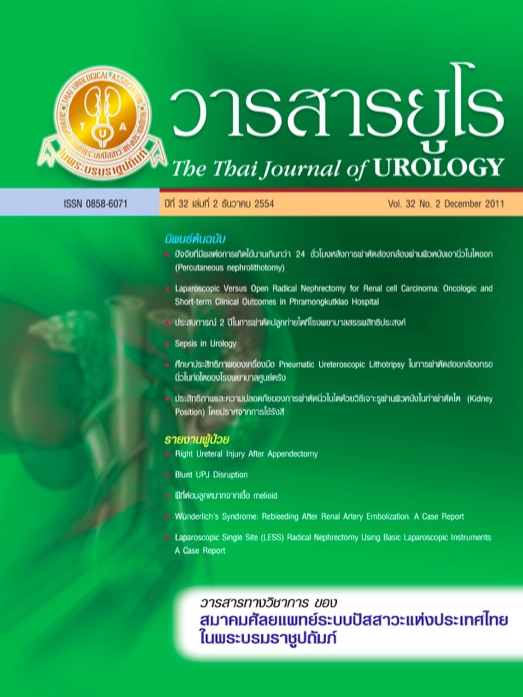Pneumatic Ureteroscopic Lithotripsy for all Ureteral Stones in Trang Hospital
Keywords:
Pneumatic, Ureteroscopic, Lithotripsy, Ureteral StonesAbstract
Background and Purpose: Shock wave Lithotripsy (SWL) has a variable but low success rate for large or non-opaque ureteral stones. Ureteroscopic stone manipulation may be the best option for all stone size, consistency and position of ureteral stones. This report examines the feasibility and effectiveness of pneumatic ureteroscopic lithotripsy for all ureteral stones.
Patients and Methods: 612 patients with impacted ureteral stones were treated with URSL using 6/7.5 F Semirigid tapering ureterorenoscope and pneumatic lithotriptor under regional or general anesthesia. Double- J Ureteral stent were placed in all patients owing to the large stone burden, edema of the intraluminal mucosa and accompanying ureteric injury. Success was defined as stone free status on parameters and outcomes were analyzed.
Result: The accessibility rate of the stone was 99.3% (608 of 612) and the stone free rate for the first achived after one setting was 78% (480 of 612), after the second or the third URSL with adjuvant treatment, the total stone free rate reached 100%. No patient needed open surgery and there were no major intra-operative complications.
Conclusion: Although 22% of patients needed the second or the third URSL with adjuvant treatment pneumatic ureteroscopic lithotripsy can be considered the best choice for all ureteral stones.
References
Chaimuangraj S, Leungwattanakij S, Gojaseni P. The current therapy of urinary calculi in Thailand. J Med Assoc Thai 2000; 83(7): 701-7.
Segura JW, Preminger GM, Assimos DG, Dretler SP, Kahn RI, Lingeman JE, et al. Ureteral Stones Clinical Guidelines Panel summary report on the management of ureteral calculi. The American Urological Association. J Urol 1997; 158(5):1915-21.
Turk TMT, Jenkins AD. A comparison of ureteroscopy to in situ extracorporeal shock wave lithotripsy for the treatment of distal ureteral calculi. J Urol 1999; 161:45.
Hosking DH, Bard RJ. Ureteroscopy with intravenous sedation for treatment of distal ureteral calculi: A safe and effective alternative to shock wave lithotripsy. J Urol 1996; 156:899-901.
Peschel R, Janetsckek G, Bartsch G. Extracorporeal shock wave lithotripsy versus ureteroscopy for distal ureteral calculi: A prospective randomized study. J Urol 1999; 162:1909-12.
Hendrikx AJ, Strijbos WE, de Knijff DW, Kums JJ, Doesburg WH, Lemmens WA. Treatment for extended-mid and distal ureteral stones: SWL or ureteroscopy? Result of a multicenter study. J Endourol 1999; 13:727-33.
Maheshwari PN, Oswal AT, Andankar M, Nanjappa KM, Bansal M. Is antegrade ureteroscopy better than retrograde ureteroscopy for impacted large upper ureteral calculi? J Endourol 1999; 13(6):441-4.
Dretler SP, Keating MA, Riley J. An algorithm for the management of ureteral calculi. J Urol 1986; 136:1190-3.
Lingeman JE, Shirrell WL, Newman DM, Mosbaugh PG, Steele RE, Woods JR. Management of upper ureteral calculi with extracorporeal shock wave lithotripsy. J Urol 1987; 138(4):720-3.
Dushinski JW, Lingeman JE. Urologic applications of the holmium laser. Techn Urol 1997; 3:60-4.
Cheung MC, Lee F, Yip SKH, Tam PC. Out patient holmium laser lithotripsy using semi-rigid ureteroscope. Eur Urol 2001; 39: 702-8.



